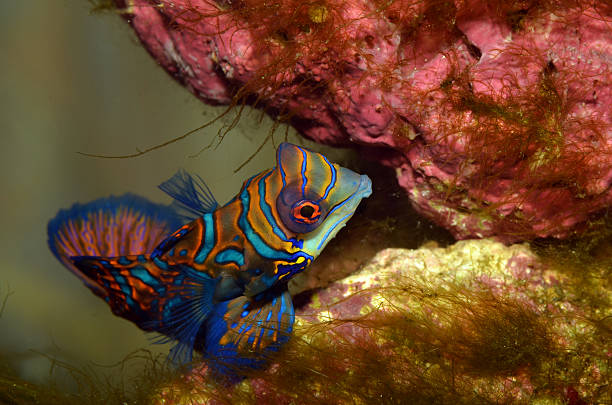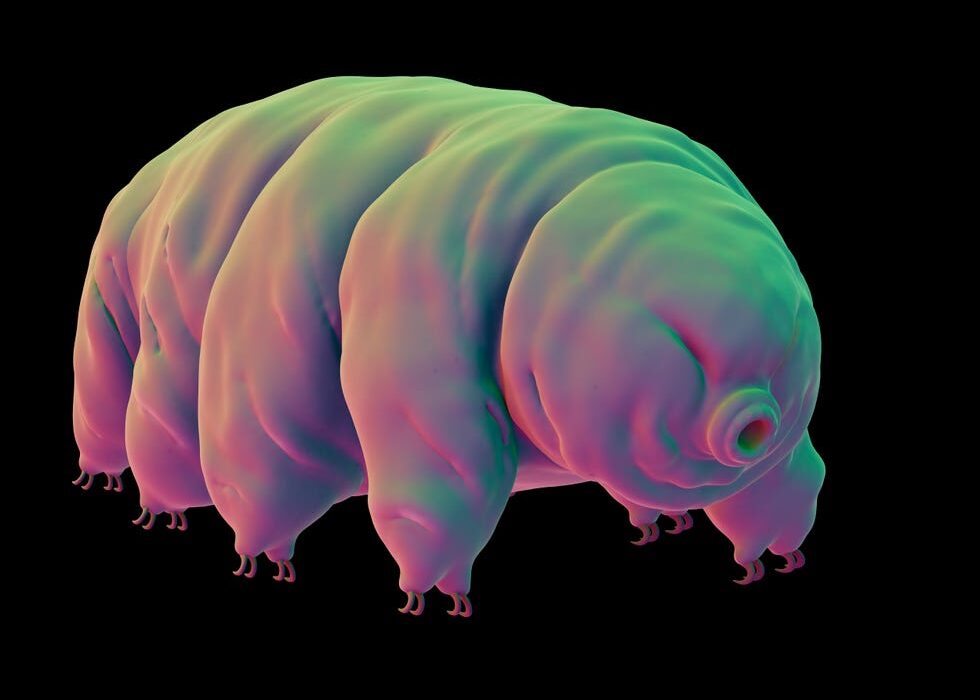The ocean is the world’s most mesmerizing art gallery, painted in every hue imaginable. Beneath its surface swim living rainbows—fish that shimmer, glow, and dazzle with colors so vibrant they seem to come from dreams rather than biology. These creatures aren’t just beautiful; their colors tell stories of survival, love, and evolution. Some use brilliant pigments to attract mates, others to camouflage or to warn predators of danger.
Color, in the ocean, is more than decoration—it’s language. It’s life itself, written in iridescent scales and flashing fins. Today, we’ll dive deep into the world of the fifteen most colorful fish on Earth, exploring their unique beauty, their hidden worlds, and the science that makes them shine.
1. Mandarin Fish – The Jewel of the Coral Sea
Few creatures rival the Mandarin Fish when it comes to pure, surreal beauty. Found in the warm waters of the Pacific Ocean, especially around the Philippines, Australia, and Indonesia, this tiny dragonet looks like it was painted by hand.
Its body glows with electric blues, vibrant oranges, and emerald greens. The patterns are intricate and hypnotic, almost psychedelic in their complexity. The secret behind its radiant blue hue isn’t pigment but cellular structure. Specialized cells called iridophores reflect light in a way that produces those glowing tones—a phenomenon known as structural coloration.
Mandarin Fish are notoriously shy, preferring to hide among coral and rubble. They glide gracefully, almost like butterflies underwater. Their courtship ritual is a slow, mesmerizing dance, where male and female ascend together toward the surface, glowing in unison before releasing their eggs.
Their beauty is matched only by their delicacy. They’re small, peaceful, and elusive—a true gem hidden in the vastness of the ocean.
2. Clownfish – The Ocean’s Bright Little Star
Clownfish are perhaps the ocean’s most beloved celebrities, thanks to their star turn in Finding Nemo. But beyond the fame lies one of nature’s most extraordinary creatures, painted in vivid orange, white, and black.
These fish live symbiotically with sea anemones, whose stinging tentacles provide both shelter and defense. The clownfish’s skin secretes a special mucus that prevents it from being stung, allowing it to live safely among anemone arms that would paralyze most other fish.
Their coloration serves as both camouflage and warning. The bright stripes help them blend into the waving tentacles, while also signaling toxicity to predators. Clownfish are also social creatures with a fascinating twist—each group is led by a dominant female, and if she dies, the most dominant male changes sex to take her place.
They are a perfect marriage of beauty, intelligence, and adaptation—a splash of joy in every coral reef they call home.
3. Royal Gramma – The Purple Prince of the Caribbean
If royalty had scales, it would look like the Royal Gramma. This small, graceful fish from the Caribbean Sea flaunts a striking gradient that fades from rich violet to golden yellow. It’s as if the sunset and twilight merged into one creature.
Royal Grammas are beloved by divers and aquarists alike. They’re shy but curious, often darting in and out of rock crevices in coral reefs. Their vivid colors serve both aesthetic and biological purposes: the deep purple end helps them blend into shadowed reef areas, while the yellow tail distracts predators by drawing attention away from their head.
In aquariums, they’re peaceful, elegant swimmers that add a regal glow to any environment. In the wild, they represent one of the Caribbean’s most dazzling examples of nature’s artistry.
4. Lionfish – The Striped Assassin
Few fish are as breathtaking—and as dangerous—as the Lionfish. With its flowing, venom-tipped spines and bold zebra-like stripes, it looks both angelic and deadly. Native to the Indo-Pacific, this fish is now notorious as an invasive species in the Atlantic, where it has spread rapidly and disrupted ecosystems.
Despite its reputation, the Lionfish remains one of the ocean’s most stunning visual spectacles. Its fins spread like delicate fans, moving in slow, mesmerizing rhythm. The alternating bands of red, white, and brown make it appear almost regal—a living piece of art that conceals its venomous power.
The Lionfish uses its fins to herd smaller fish before striking with lightning speed. Its sting isn’t usually fatal to humans but can cause intense pain. In the underwater world, however, it’s a reminder that beauty and danger often coexist in perfect balance.
5. Parrotfish – The Painter of Coral Reefs
If the reefs of the world are living cities, Parrotfish are their artists and caretakers. These colorful creatures, named for their beak-like mouths, play a crucial ecological role by eating algae and dead coral, helping reefs stay healthy and vibrant.
Their coloration is a masterpiece—brilliant blues, greens, pinks, and purples blend in swirling patterns that seem almost impossible to describe. Some species change color as they mature or when they switch sexes, as many Parrotfish are sequential hermaphrodites, meaning they can change from female to male during their life.
Even more fascinating is their nighttime ritual. Parrotfish secrete a mucus “sleeping bag” around themselves at night, which masks their scent from predators. By day, they nibble coral and excrete fine white sand—yes, much of the tropical sand beneath your feet was once part of a coral reef, processed by a Parrotfish.
They’re nature’s living rainbows and sculptors of the sea floor.
6. Moorish Idol – The Icon of Elegance
Few fish are as instantly recognizable as the Moorish Idol, with its sleek body, bold black-and-white stripes, and trailing yellow dorsal fin that flows like a silk ribbon.
Found throughout the Indo-Pacific, from Hawaii to the Red Sea, Moorish Idols are symbols of grace and beauty. Their name comes from the Moors of Africa, who believed the fish brought happiness and good fortune.
They feed on coral, sponges, and tunicates, gliding through reefs in pairs that often mate for life. Their colors—bright yet balanced—make them appear both royal and serene.
Because of their sensitivity, they’re notoriously difficult to keep in aquariums, a fact that adds to their mystique. To see a Moorish Idol in the wild is to witness one of nature’s purest expressions of beauty in motion.
7. Emperor Angelfish – The Regal Masterpiece
The Emperor Angelfish looks like it swam straight out of a dream. As juveniles, their bodies are marked with hypnotic blue and white spirals, which gradually transform into the bold, royal stripes of adults—bands of yellow, blue, and black arranged in perfect harmony.
This transformation is so striking that for many years scientists thought the juvenile and adult were separate species.
Emperor Angelfish inhabit coral reefs throughout the Indo-Pacific and are known for their commanding presence. Their patterns serve both beauty and biology: the bold stripes help break up their shape, confusing predators among the corals.
They feed on sponges and algae, maintaining the ecological balance of their habitats. Their movements are slow and deliberate, exuding confidence—as if fully aware of their royal title.
To see one glide through the reef is to witness living art.
8. Clown Triggerfish – The Underwater Fashionista
The Clown Triggerfish looks as if it was designed by a modern artist with a flair for bold contrasts. Its body is a perfect mix of geometric patterns—white polka dots on a jet-black belly, a yellow snout, and a honeycomb-like upper half that radiates complexity.
Found in tropical Indo-Pacific waters, this species combines fierce beauty with fierce personality. Triggerfish are territorial and can be aggressive when protecting their nesting sites, but their intelligence and confidence make them mesmerizing to watch.
The Clown Triggerfish’s coloration isn’t just for show—it’s camouflage. The black-and-white patterns disrupt its outline, making it harder for predators to recognize its true shape.
They feed on crustaceans, sea urchins, and small fish, using strong jaws and teeth to crush hard shells. With their striking design and bold behavior, they embody the ocean’s spirit: dazzling, defiant, and utterly unique.
9. Regal Tang – The Blue Marvel
Known affectionately as “Dory” from Finding Nemo, the Regal Tang (or Blue Tang) is a symbol of the ocean’s serene beauty. Its vibrant royal blue body, contrasted with a bright yellow tail and black markings, makes it one of the most recognizable fish in the sea.
Found throughout the Indo-Pacific, the Regal Tang’s coloration serves as both camouflage and warning. When threatened, it hides among coral, flattening its body to blend in with shadows. Its spine-tipped tail can deliver a sharp defensive flick to predators.
Despite its fame, the Regal Tang plays an important ecological role—it feeds on algae that could otherwise overgrow and damage coral reefs. Its beauty, therefore, is not only visual but vital to the health of marine ecosystems.
Watching a Regal Tang dart through coral gardens feels like watching the sea itself come to life in color.
10. Flame Angelfish – The Fire of the Reef
The Flame Angelfish burns bright beneath the waves. Native to the tropical waters of the Pacific, particularly around Tahiti and the Cook Islands, this small fish glows with radiant orange-red hues, striped vertically with deep black bars.
Its vivid coloration earns it its fiery name, and when sunlight pierces the water, the Flame Angelfish seems to ignite like a spark of living fire.
Despite its bold looks, it’s a peaceful reef dweller, feeding on algae and small invertebrates. Males and females display subtle color differences, with males often slightly larger and more vibrantly hued.
Their beauty is nature’s way of celebrating balance—intensity wrapped in grace, flame contained in water.
11. Peacock Cichlid – The Jewel of African Lakes
While most colorful fish come from the ocean, freshwater has its own masterpieces—none more radiant than the Peacock Cichlid of Africa’s Lake Malawi.
Named for their dazzling colors, which rival even coral reef fish, Peacock Cichlids shimmer in metallic blues, greens, yellows, and reds. Each species—and sometimes each individual—has its own unique color pattern, often used to attract mates or defend territory.
These fish are highly intelligent and social. Males display their full colors during courtship, performing elaborate dances to impress females. The lake they inhabit is home to hundreds of cichlid species, each evolving different colors and behaviors to adapt to the same environment—a living experiment in evolution and beauty.
In aquariums, Peacock Cichlids are like moving gemstones, proof that brilliance isn’t limited to saltwater realms.
12. Rainbow Wrasse – The Color-Shifting Wonder
Few fish change color as dynamically as the Rainbow Wrasse. Found in the Mediterranean and eastern Atlantic, these slender, graceful fish display dazzling combinations of red, green, yellow, and blue—often shifting hues with age, mood, or sex.
The males, in particular, glow with iridescent brilliance during mating season, flashing colors that seem to dance across their scales. Like many wrasses, they are sequential hermaphrodites—born female and later changing to male as they mature.
Rainbow Wrasses are constantly active, darting among rocks and reefs in search of food. Their bright patterns not only attract mates but also signal strength and vitality.
They are living kaleidoscopes, symbols of transformation, and proof that beauty in nature is never static—it evolves, it glimmers, it lives.
13. Picasso Triggerfish – The Artistic Oddity
It’s no surprise that this fish bears the name of one of history’s greatest artists. The Picasso Triggerfish is a living abstract painting, with angular patterns of blue, yellow, black, and white crisscrossing its face and body in mesmerizing ways.
Found in the shallow reefs of the Indo-Pacific, it’s known for its intelligence and curiosity. Picasso Triggerfish often approach divers, inspecting them with expressive eyes that seem to follow every movement.
Their colors, though stunning, serve an evolutionary purpose—breaking up their shape against the coral background and confusing predators. They also use sounds and movements to communicate, grunting or clicking when threatened.
They’re bold, beautiful, and unmistakably individual—like brushstrokes of genius beneath the sea.
14. Blueface Angelfish – The Ocean’s Masked Beauty
The Blueface Angelfish, native to the Indo-Pacific, wears one of the most distinctive “faces” in the fish world. Its head glows electric blue, marked with intricate golden lines that resemble a celestial map, while its body shimmers in shades of yellow and indigo.
Juveniles look entirely different, with circular blue and white bands—a transformation so dramatic it feels like watching evolution in fast-forward.
Blueface Angelfish inhabit coral reefs rich with sponges and algae, their primary diet. They’re solitary creatures, often found gliding through reef edges with quiet majesty.
Their appearance combines strength with elegance—a perfect blend of structure and grace, reminding us how complex and deliberate nature’s artistry can be.
15. Betta Fish – The Siamese Jewel
No list of colorful fish would be complete without the Betta, or Siamese Fighting Fish. Though originally native to Thailand and Cambodia’s rice paddies, Bettas are now celebrated worldwide for their breathtaking beauty and variety.
Their long, flowing fins and extraordinary color range—reds, blues, purples, greens, even iridescent metallics—make them living jewels. These colors intensify with mood and dominance; males, in particular, flare their fins in displays of power and beauty.
Bettas breathe air as well as water thanks to a unique organ called the labyrinth, allowing them to thrive in low-oxygen environments. They’re fiercely territorial yet deeply intelligent, recognizing their owners and even learning simple tricks.
Their elegance and passion make them symbols of resilience—tiny warriors that prove beauty and strength can coexist in perfect harmony.
The Science of Color Beneath the Waves
The colors we see underwater are a miracle of physics and biology. Many fish display hues through two main mechanisms: pigmentation and structural coloration. Pigments absorb certain wavelengths of light and reflect others, creating reds, yellows, and oranges. Structural coloration, on the other hand, results from microscopic surface structures that reflect and scatter light, producing blues, purples, and iridescent effects.
In shallow waters, sunlight penetrates enough to reveal every shade. But deeper down, red wavelengths disappear first, leaving only blues and greens. That’s why deep-sea creatures often appear darker or bioluminescent—they must create their own light to be seen.
Color also serves complex functions: communication, camouflage, mating, and defense. To the untrained eye, a fish’s patterns may seem random, but to other fish, they convey precise messages—dominance, readiness to mate, or warnings to stay away.
The Emotional Power of Color
Color affects not only fish but us. The sight of a glowing Mandarin Fish or an Emperor Angelfish evokes wonder that transcends science. It touches something primal—our human fascination with light, pattern, and life itself.
Each of these fifteen species is a reminder that nature is both artist and engineer, blending beauty and survival into one seamless design. Their colors tell stories of adaptation, resilience, and evolution, reflecting millions of years of history written not in words, but in light.
The Final Splash
In every coral crevice and ocean current, color thrives as a language older than humanity. These fish—the living rainbows of the sea—are more than ornaments; they’re storytellers, carrying the ancient tales of the ocean’s creation, struggle, and splendor.
To witness them is to feel both awe and gratitude, to realize that beneath the waves lies a universe painted by nature’s own hand. Every shimmer is a heartbeat, every hue a whisper of the deep, reminding us that the ocean doesn’t just hold life—it creates beauty.






